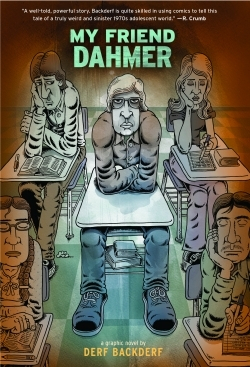My Friend Dahmer
In the hands of a less talented creator, My Friend Dahmer would find its place alongside other “True Crime” books, volumes that mostly give readers the gory details in superheated prose, but which provide little insight into how such monsters are born. Fortunately, cartoonist Derf Backderf isn’t one to avoid the troubling, even terrifying, truths that lurk in the dark recesses of that notorious serial killer’s early life—and modern American life itself.
As the title suggests, Backderf did know Dahmer. They first met during the 1970s, while both were attending junior high school in Eastville, Ohio. However, he’s quick to reveal the lie behind his title by repeatedly demonstrating throughout this harrowing volume that no one laid even passing claim to the title of “friend” to Dahmer during high school. Worse still, it seems that there was no adult—no parent, guardian, or educator—who demonstrated a modicum of real, sustained interest in that troubled youth’s life.
Instead, what little human contact the teenaged Dahmer had with others was superficial at best. More often he was excluded, ignored, or served as the scapegoat of bullies, both an object of derision for his classmates and a neglected burden to his family and acquaintances. For Backderf and his fellows, he was a caustic class clown, the weird kid who could be bribed with booze to perform outrageous imitations of a local handicapped man for their enjoyment. Ultimately, Dahmer was easily discarded and barred from any hope of friendship once these heartless games ceased to amuse them.
All of this is presented in Backderf’s
signature style, which places elongated, blocky figures against realistically rendered backgrounds. This lends both the players and their environs a real sense of weight that is bolstered by his fluid line work combined with a superior use of both negative space and shadows. And it’s those same abilities that imbue the features and physiques of these characters with a depth of emotion that belies their two-dimensional natures. This is cartooning of the highest caliber, an approach which—working in tandem with Backderf’s understated and seamless script—ensures a fascinating, if,
ultimately bleak, reading experience.
The most disturbing aspect of this tale is how all of the adults in Dahmer’s life utterly failed him. According to this account, not one questioned the increasingly haunted youth about his fascination with collecting and dissecting road kill, or investigated his growing absences from school (when he attended at all) or his increasing dependence on alcohol, which eventually left him a reeking stumblebum. Readers have to wonder how different things might have been if anyone had taken this troubled teen in hand or shown even a glimmer of interest in him.
And that’s the terrible, unspoken truth coiled around the bleak heart of this story; the sad realization that things might have been different, followed by a prayer that our own children do not, will not, lead lives that mask their own private hell.
Reviewed by
Bill Baker
Disclosure: This article is not an endorsement, but a review. The publisher of this book provided free copies of the book to have their book reviewed by a professional reviewer. No fee was paid by the publisher for this review. Foreword Reviews only recommends books that we love. Foreword Magazine, Inc. is disclosing this in accordance with the Federal Trade Commission’s 16 CFR, Part 255.

